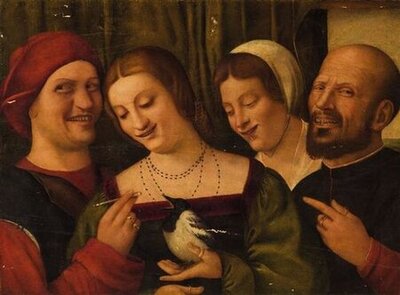Kunst bij Jimmink
Na jaren van onderzoek hebben de experts van het BRCP een nieuwe tekening van Jheronimus Bosch ontdekt.
WIJ INFORMEREN U GRAAG OVER DE MOGELIJKHEDEN VAN AANKOOP
WIJ INFORMEREN U GRAAG OVER DE MOGELIJKHEDEN VAN AANKOOP
Infernal Landscape
Original drawing by Jheronimus Bosch
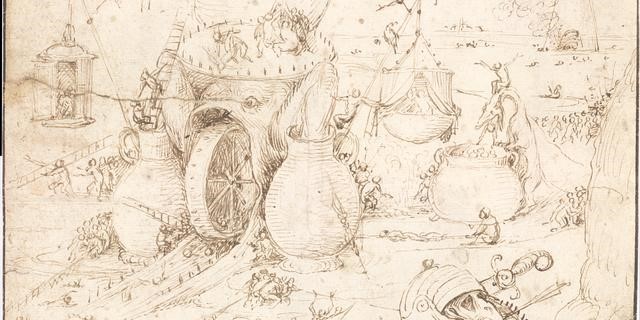
31 oktober 2015
De tekening Hellelandschap, die in privé-bezit is, is door het Bosch Research and Conservation Project (BRCP) herkend als authentiek van Bosch. Tot nu toe werd gedacht dat het werk met fantasie-monsters en gedrochten van een medewerker was van een kunstenaar die in het atelier van de beroemde kunstenaar werkte.
De tekening is voor het eerst te zien op de grote overzichtstentoonstelling 'Jheronimus Bosch-Visioenen van een genie' die op 13 februari volgend jaar opent in het Noordbrabants Museum in Den Bosch.
Argumenten
Bij de tekening gaat het juist om een werk van de hand van de meester zelf. ''Het is het visueel schouwspel dat we boschiaans zijn gaan noemen en ook tegenkomen in Bosch’ schilderijen met hellescènes, zoals de Tuin der Lusten en de Laatste Oordeeltriptieken.''
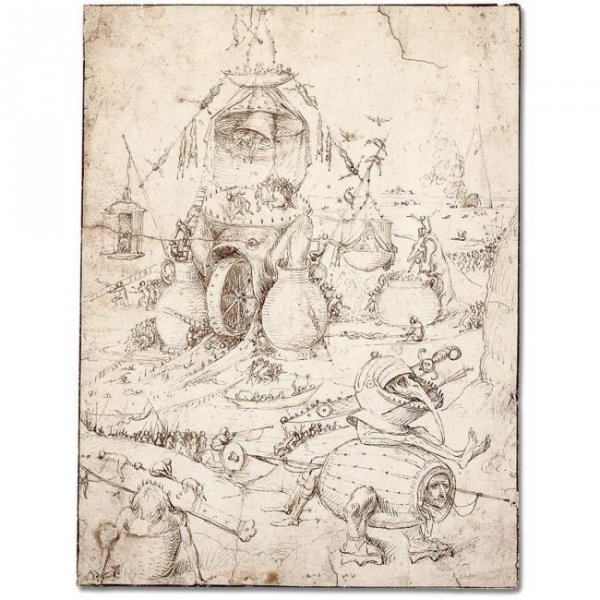
Original drawing by Jheronimus Bosch around 1500-05
Infernal Landscape
Type: Pen and brown ink
Size: 25.9 x 19.7 cm
Arguments
Infernal Landscape previously thought to have been made by an assistant in the workshop of medieval Dutch artist Jheronimus Bosch has been authenticated as a piece by the master himself by the Bosch Research and Conservation Project (BRCP). The BRCP is an international art history study that has been researching, analyzing and documenting the oeuvre of the medieval master since 2010.
Technology reveals the truth “It’s not just a ‘successful pastiche’, as some have called it.
I’ve seen quite a few of these, and 99% of the time, they are not very inspiring,” Ilsink says.
“This one is very, very good.”
He says the argument that the work is “too Bosch to be by Bosch” does not hold water, given the fact that other, equally “Boschian” drawings—including Tree Man (around 1505) in Vienna’s Albertina—are considered to be authentic works.
“You can’t blame Bosch for being too Bosch,” he says BRCP-researcher Matthijs Ilsink.
This "Man in basket" can be found as underdrawing of the most famous painting by Bosch "Garden of Earthly Delights" (1500-05) in the Prado.
 <<<<<here is the detail of the "tonman"
<<<<<here is the detail of the "tonman" under the paint of the Hell wing

Technology reveals the truth: IT IS ORIGINAL BY BOSCH!
Infrared reflectography and ultra-high-resolution digital macro photography, in infrared and visible light, were used to document the work.
The paper, handwriting and inks were compared with drawings from important collections in Berlin, Vienna, Paris and Rotterdam. X-rays revealed links between figures in Infernal Landscape and those hidden beneath the paint layers of other works.
For example, the man in a basket is similar to one in an underdrawing on the
“Hell wing” of the artist’s famous work Garden of Earthly Delights (1500-05), in the Museo del Prado, Madrid.
Ilsink says that Bosch often changed his mind as he worked, so his paintings have a lot of overpaint and underdrawings.
“Someone creating a pastiche of his works wouldn’t have access to these earlier versions,” Ilsink says.
He admits that some might argue that Infernal Landscape was made in the artist’s workshop, but he does not believe this to be the case.
A FEASTING GROUP OF JEWS
Een Joods gezelschap dat eet, drinkt en muziek maakt
Giovan Paolo Lomazzo or Jan Matsys(?)
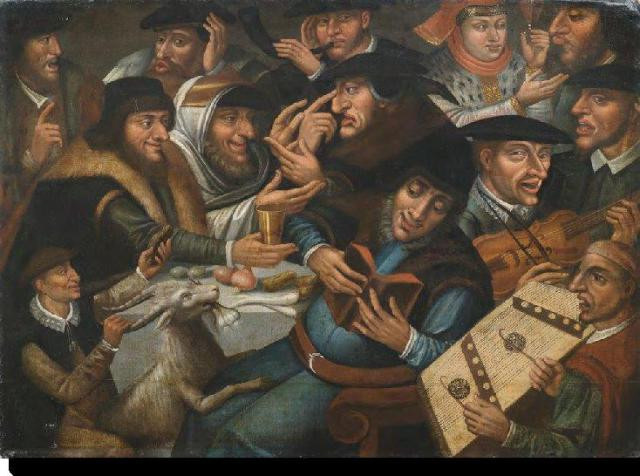
details

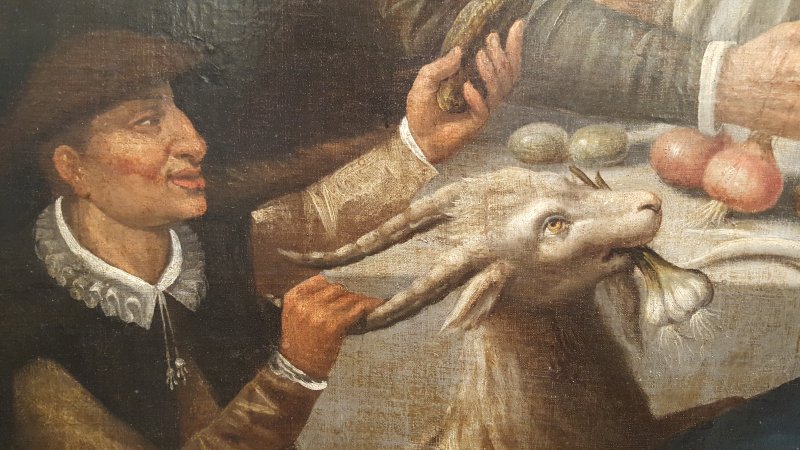
Probably circle of Giovan Paolo Lomazzo (Milan 1538-1592)
Oil on canvas
99,2 x 132 cm
A feasting group of Jews, making music with a tsimbl and a modern violin (invented in 1555 by Andrea Amati .
Or probably circle of Jan Massijs of Jan Matsys (c.1510 - 8 oktober 1575)
A feasting group of Jews, making music with a tsimbl and a modern violin (invented in 1555 by Andrea Amati in Cremona)

The tsimbl (Eng., cimbalom) is an instrument of the dulcimer family, a trapezoidal box with strings in courses of two to six, some of which are divided into fifths by a partitioning bridge. The cimbaloms played by Jews generally had a range of two and a half octaves and were tuned chromatically; the metal (mainly brass) strings were struck with wooden hammers.
De tsimbl (Eng., cimbalom) is een instrument uit de hakkebordfamilie, een trapeziumvormige doos met snaren in reeksen van twee tot zes, waarvan sommige door een scheidingsbrug in kwinten zijn verdeeld. De door joden bespeelde cimbaloms hadden over het algemeen een bereik van twee en een halve octaaf en waren chromatisch gestemd; de metalen (voornamelijk koperen) snaren werden aangeslagen met houten hamers.
The Amati were a family from Cremona – a city in Lombardy – who built violins approximately between 1550 and 1740. The family is responsible for the shape of the modern violin. Andrea Amati, the first violin maker in the family, built his first violin on commission for Lorenzo de Medici in 1555. The Medici loved Andrea's violins, because in 1560 Catherine de Medici ordered another 38 copies.
De Amati waren een familie uit Cremona – een stad in Lombardije – die ongeveer tussen 1550 en 1740 violen bouwden. De familie is verantwoordelijk voor de vorm van de moderne viool. Andrea Amati, de eerste vioolbouwer in de familie, bouwde zijn eerste viool in opdracht voor Lorenzo de Medici in 1555. De Medici hielden van Andrea’s violen, want in 1560 bestelde Catherine de Medici nog eens 38 exemplaren.
Oil on canvas 99,2 x 132 cm
Vlaamse renaissanceschilder bekend om zijn historieschilderijen , genretaferelen en landschappen .
click here to compare with other work by Lomazo click here to compare with other work by Massijs
Drie mannen met een vrouw die een ekster vasthoudt Een vrolijk gezelschap

Een deel van onze kunstafdeling in de Literaire Salon
Set of 16 miniatures from the lives of the Virgin Mary and Jesus
Jan Brueghel the Elder (Flemish, 1568–1625)


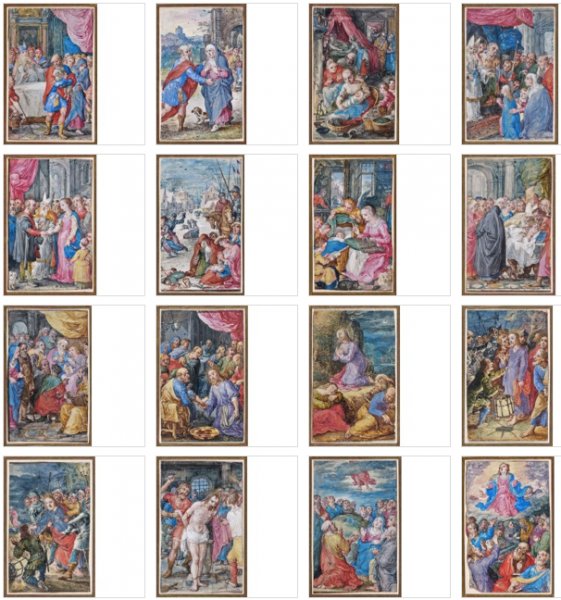
tempera on vellum
Size:
7.4 x 4.8 cm. (2.9 x 1.9 in.)
Jan Brueghel (also Bruegel or Breughel) the Elder 1568 – 13 January 1625)
A Flemish painter and draughtsman. He was the son of the eminent Flemish Renaissance painter Pieter Bruegel the Elder. A close friend and frequent collaborator with Peter Paul Rubens, the two artists were the leading Flemish painters in the first three decades of the 17th century.
Brueghel worked in many genres including history paintings, flower still lifes, allegorical and mythological scenes, landscapes and seascapes, hunting pieces, village scenes, battle scenes and scenes of hellfire and the underworld. He was an important innovator who invented new types of paintings such as flower garland paintings, paradise landscapes, and gallery paintings in the first quarter of the 17th century.
He further created genre paintings that were imitations, pastiches and reworkings of his father's works, in particular his father's genre scenes and landscapes with peasants. Brueghel represented the type of the pictor doctus, the erudite painter whose works are informed by the religious motifs and aspirations of the Catholic Counter-Reformation as well as the scientific revolution with its interest in accurate description and classification. He was court painter of the Archduke and Duchess Albrecht and Isabella, the governors of the Habsburg Netherlands.
The artist was nicknamed "Velvet" Brueghel, "Flower" Brueghel, and "Paradise" Brueghel. The first is believed to have been given him because of his mastery in the rendering of fabrics. The second nickname is a reference to his specialization in flower still lifes and the last one to his invention of the genre of the paradise landscape. His brother Pieter Brueghel the Younger was traditionally nicknamed "de helse Brueghel" or "Hell Brueghel" because it was believed he was the author of a number of paintings with fantastic depictions of fire and grotesque imagery. These paintings have now been reattributed to Jan Brueghel the Elder.
Lucebert
Lubertus Jacobus Swaanswijk (1924 - 1994)
Kunstenaar: Lucebert (1924-1994) geniet bekendheid als voorman van de Vijftigers, maar met zijn figuratief-expressionistisch beeldend werk ook als exponent van de Cobra-beweging. Zijn werk is o.m. vertegenwoordigd in het Stedelijk Museum Amsterdam, Stedelijk Museum in Schiedam en het Cobra Museum.
Zwerver aan zee
LUCEBERT (Dutch 1924 - 1994). Zwerver aan zee [Wanderer by the sea], 1987.
Screenprint in colours, signed and dated 'lucebert '87' (lower right), numbered '39/40'
(lower left) and titled (lower centre); framed behind glass.
Jaar: 1987.
Techniek: zeefdruk.
Oplage: 39/40.
Afmeting afbeelding: 61×45 cm.
Afmeting papier: 70×53 cm.
Signatuur: r.o. met potlood.

Lucebert - kleurenzeefdruk - ' Zwerver aan zee' - 1987 (KLEINE OPLAGE)

Lucebert - kleurenzeefdruk - ' Weduwe van de zee' - 1987 (KLEINE OPLAGE)
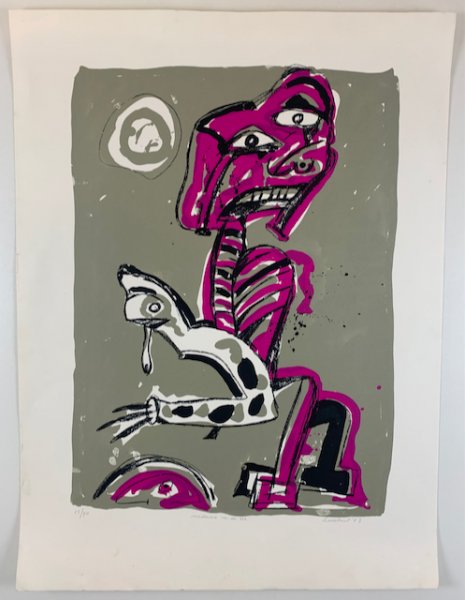
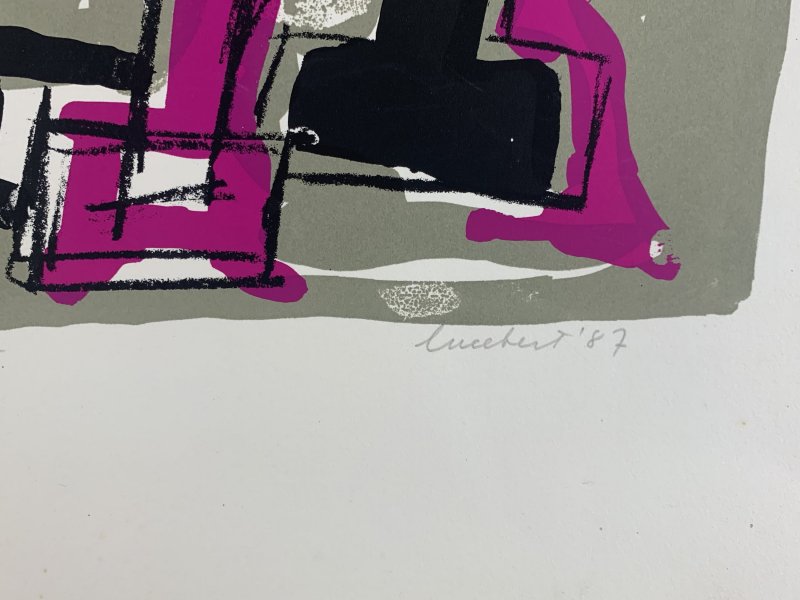
Weduwe van de zee
Jaar: 1987.
Techniek: zeefdruk.
Oplage: 39/40.
Afmeting afbeelding: 61×45 cm.
Afmeting papier: 70×53 cm.
Signatuur: r.o. met potlood.
Landscape with farmhouse and raincloud
Chris Huidekoper
geboren 2 juni 1878 Groningen
gestorven 14 november 1939 Rabat (Marokko)
alternatieve namen Chris Huidekoper, Chris Huidekooper, Christiaan Huidekooper
Chris Huidekoper was a Dutch painter, watercolourist and draftsman. He was also a writer.
He travelled through Italy, Germany and Spain and was a member of the artist association Arti et Amicitiae, Amsterdam.
He was the pupil of Johannes Daniël Belmer and Jac van Looy and painted Christian religious scenes, landscapes, still lifes and portraits.

Landscape
oil on canvas
signed
Chris Huidekoper en '16
geboren 2 juni 1878 Groningen
gestorven 14 november 1939 Rabat (Marokko)
alternatieve namen
Chris Huidekooper
Christiaan Huidekooper

Kruikje op wit laken
Kees Blom
olieverf op paneel
24 x 16
gesigneerd r.o. en 2007
Kees Blom (Apeldoorn, 1968) komt uit een artistieke familie. Zijn vader had al een passie voor de schilderkunst maar pas zoon Kees lukt het om de stap naar zelfstandig kunstschilder te zetten. De eerste tekenlessen, de liefde voor de natuur en het filosoferen leerde hij van zijn vader en diens schildervrienden. Op jonge leeftijd was Kees al aan het tekenen waaronder een hele grote zon waarin alle huizen, de mensen en de bomen pasten. Een zesjarige schilderfilosoof in de dop, waar school niet zo blij mee was. Zijn ogen en oren kregen al vroeg een veelzijdige training en het leven zelf zorgde voor de verdere opleiding.

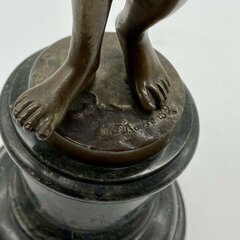
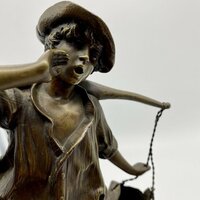
Waterdrager
Franz Rosse (1858-1900)
Staande op een hoge ronde voet van groen marmer, een jonge jongen in een boerengewaad, blootsvoets met opgerolde broekspijpen en een wijd hemd. Hij draagt een lang juk over zijn schouders en balanceert er twee emmers water op. Hij houdt een van zijn handen voor zijn mond als trechter om kopers te lokken. Hoogwaardig, donker gepatineerd brons. Gesigneerd F. Rosse op de sokkel, gedateerd 1897. De beeldhouwer Rosse woonde en werkte in Berlijn. Hij werd opgeleid in Hanau aan de staatstekenacademie onder Max Wiese en vervolgens onder Fritz Schaper aan de Berlijnse academie. Zijn bekendste werk is het Kaiser Wilhelm Memorial in Rathenow. (Thieme-Becker). 39 x 25 x 11 cm.
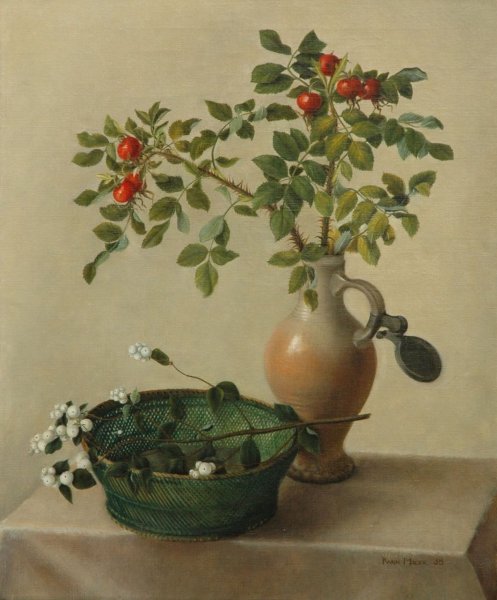
Stilleven met bessen en rozenbottels
Karin Mader
1910-1973
olieverf op doek
60,2 x 50,3 cm,
gesigneerd rechtsonder
gedateerd '38
Patty Harpenau (b.1959) "Woman kneeling down"



Harpenau, Patty (b.1959) Woman kneeling down. Col. silkscreen, 60x54 cm., signed G.A. 7/15
"Patty Harpenau" "life ain't bad at all with you, "good old kwaster van me" "
De tekst is gericht aan Panda de l'Isle die haar vaak hielp. Prachtig ingelijst.

Martin Monnickendam, gezicht vanuit zijn huis aan de Amstel.
VERKOCHT
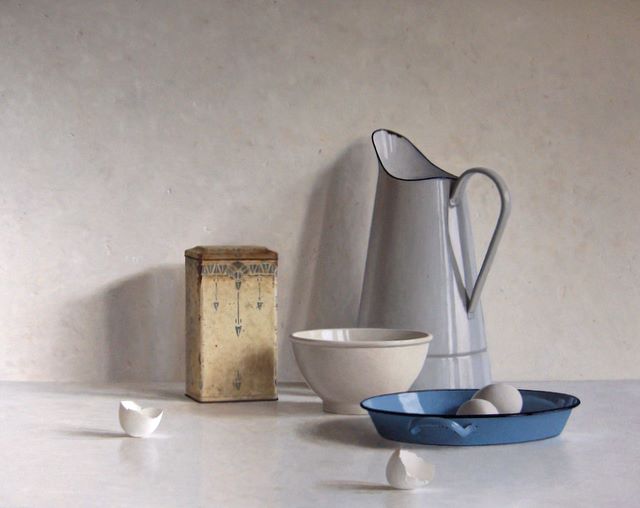
Willem de Bont, stilleven met eieren
Willem de Bont (1953) heeft het eeuwenoude genre van het stilleven op hedendaagse wijze vorm en inhoud gegeven. Een niet te onderschatten charme van het stilleven ligt voor deze kunstenaar in het feit dat de schilder alles zelf in de hand heeft. Hij stelt het immers zelf samen, wat een eindeloos scala aan variatiemogelijkheden biedt. Vergaande vereenvoudiging van zowel kleur als vorm bepaalt het karakter van het werk van De Bont. Niet alleen heeft hij het aantal objecten op zijn panelen sterk teruggedrongen, deze voorwerpen zijn zelf ook eenvoudig van vorm en betekenis. Altijd hebben zij een gebruiksfunctie en nooit zijn ze voor de praal bedoeld. Ook is De Bont niet bang om zijn palet te beperken tot enkel lichte tinten uit eenzelfde kleurgamma. Niet alleen zijn zijn werken dankzij de grote technische vaardigheid waarmee ze geschilderd zijn een lust voor het oog; de kunstenaar weet tevens de ziel van de beschouwer te raken.
De eenvoud die in zijn stillevens voelbaar wordt is zo krachtig dat het een haast conceptueel karakter krijgt.
Opleiding: Academie voor Kunst en Vormgeving St. Joost, ’s-Hertogenbosch
Willem de Bont (1953) has given contemporary content and form to the age-old still-life genre. For this artist, the not to be
underestimated charm of the still-life lies in the fact that he can control everything himself. After all, he creates the composition,
which opens up an infinite number of possibilities. Extreme simplicity of colour as well as form, defines the character of De Bont’s work. He has not only reduced the number of objects on his panels, these objects are also simple in form and significance. They always serve a useful purpose and are never just on display. In addition, De Bont is not afraid to limit his palette to a few light tints from the same colour spectrum. De Bont’s paintings are not just a feast for the eye due to his considerable technical skills, moreover, the artist knows how to touch the viewer’s soul.
The simplicity that becomes tangible in his still-lives is so powerful that it achieves a conceptual character.
Education: Academy of Visual Arts and Design St. Joost, ‘s-Hertogenbosch

